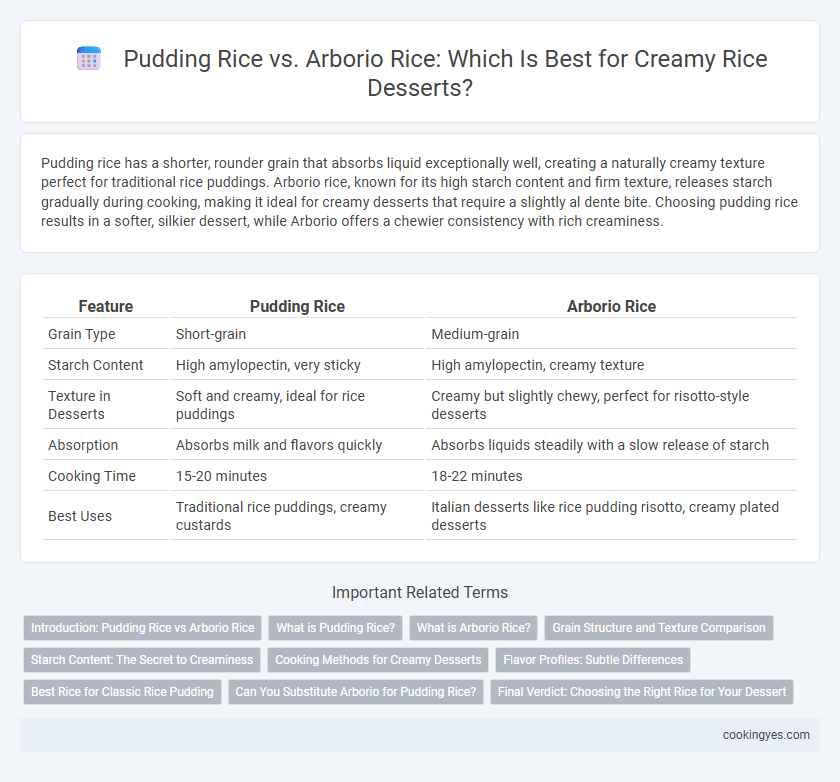Pudding rice has a shorter, rounder grain that absorbs liquid exceptionally well, creating a naturally creamy texture perfect for traditional rice puddings. Arborio rice, known for its high starch content and firm texture, releases starch gradually during cooking, making it ideal for creamy desserts that require a slightly al dente bite. Choosing pudding rice results in a softer, silkier dessert, while Arborio offers a chewier consistency with rich creaminess.
Table of Comparison
| Feature | Pudding Rice | Arborio Rice |
|---|---|---|
| Grain Type | Short-grain | Medium-grain |
| Starch Content | High amylopectin, very sticky | High amylopectin, creamy texture |
| Texture in Desserts | Soft and creamy, ideal for rice puddings | Creamy but slightly chewy, perfect for risotto-style desserts |
| Absorption | Absorbs milk and flavors quickly | Absorbs liquids steadily with a slow release of starch |
| Cooking Time | 15-20 minutes | 18-22 minutes |
| Best Uses | Traditional rice puddings, creamy custards | Italian desserts like rice pudding risotto, creamy plated desserts |
Introduction: Pudding Rice vs Arborio Rice
Pudding rice, known for its short, plump grains, absorbs milk exceptionally well, resulting in a rich and creamy texture perfect for traditional rice puddings. Arborio rice, primarily used in risottos, features a higher starch content that releases a velvety creaminess when cooked slowly, making it an excellent alternative for indulgent desserts. Both varieties offer unique textures and creaminess levels, influencing the final consistency and flavor profile of creamy rice dishes.
What is Pudding Rice?
Pudding rice is a short-grain variety known for its high amylopectin content, which creates a naturally creamy texture when cooked, making it ideal for desserts like rice pudding. Unlike Arborio rice, which is traditionally used for risottos and has a firmer bite, pudding rice absorbs more liquid and breaks down more easily, resulting in a smoother consistency. Its starch-rich composition ensures a rich and velvety finish in creamy dessert recipes.
What is Arborio Rice?
Arborio rice is a short-grain, starchy variety primarily grown in Italy, renowned for its ability to absorb liquid while maintaining a firm, creamy texture. Unlike pudding rice, which has smaller grains that cook to a soft and sticky consistency, Arborio rice retains a slight chewiness, making it ideal for creamy desserts like risotto or rice pudding with a distinctive bite. Its high amylopectin content enhances thickening properties, contributing to rich, velvety results in sweet dishes.
Grain Structure and Texture Comparison
Pudding rice features short, plump grains with a high starch content that break down easily, creating a naturally creamy texture ideal for desserts like rice pudding. Arborio rice, though also short-grain and high in amylopectin, has a firmer grain structure that maintains some bite and chewiness, making it perfect for creamy yet slightly al dente dishes such as risotto. The difference in starch release and grain integrity significantly influences the smoothness and mouthfeel of creamy rice-based desserts.
Starch Content: The Secret to Creaminess
Pudding rice contains a higher amylopectin starch content compared to Arborio rice, making it ideal for achieving a naturally creamy texture in desserts. The dense starch granules in pudding rice release more starch during cooking, which thickens the mixture and creates a smooth, velvety consistency. Arborio rice, while also high in starch, is primarily used for risottos and provides a chewier texture rather than the softness essential for classic creamy puddings.
Cooking Methods for Creamy Desserts
Pudding rice, characterized by its small, round grains, absorbs liquids slowly and thickens gradually, making it ideal for slow-simmered rice puddings that require gentle stirring and extended cooking time. Arborio rice, with its higher starch content and larger, plumper grains, releases more amylopectin during shorter cooking, producing a creamy texture quickly, suitable for recipes like rice pudding or risotto-style desserts where frequent stirring during medium heat is essential. Both varieties demand precise temperature control and frequent stirring to avoid clumping and achieve a smooth, rich consistency in creamy dessert preparations.
Flavor Profiles: Subtle Differences
Pudding rice offers a soft, sticky texture with a mildly sweet flavor that enhances creamy desserts without overpowering other ingredients. Arborio rice provides a slightly chewy bite and a nutty, robust taste, creating a richer and more textured creaminess in dishes like risotto-based puddings. Choosing between the two depends on whether a smooth, delicate finish or a heartier, pronounced flavor profile is desired in the dessert.
Best Rice for Classic Rice Pudding
Pudding rice, with its short, plump grains and high starch content, is ideal for classic rice pudding, producing a creamy and smooth texture. Arborio rice, while commonly used for risotto, also creates a rich and creamy consistency due to its amylopectin starch but offers a slightly firmer bite compared to pudding rice. For the best traditional rice pudding, pudding rice remains the preferred choice, ensuring a soft, velvety dessert.
Can You Substitute Arborio for Pudding Rice?
Arborio rice can be substituted for pudding rice in creamy dessert recipes due to its high starch content, which creates a smooth, velvety texture similar to traditional pudding rice. While pudding rice varieties like short-grain or medium-grain white rice absorb liquids evenly and yield a soft consistency, Arborio's plump, starchy grains release amylopectin during cooking, enhancing creaminess. For optimal results, adjust cooking times and liquid ratios slightly when using Arborio rice to replicate the delicate consistency typical of classic rice pudding.
Final Verdict: Choosing the Right Rice for Your Dessert
Pudding rice offers a naturally creamy texture due to its high starch content, making it ideal for traditional rice puddings that require a smooth, velvety consistency. Arborio rice, known for its firm, slightly chewy bite, absorbs flavors well and creates a rich, luxurious mouthfeel, perfect for risotto-style desserts. Selecting the right rice depends on the desired dessert texture: opt for pudding rice for classic creamy softness and Arborio rice for a more structured, indulgent creaminess.
Pudding rice vs Arborio rice for creamy desserts Infographic

 cookingyes.com
cookingyes.com